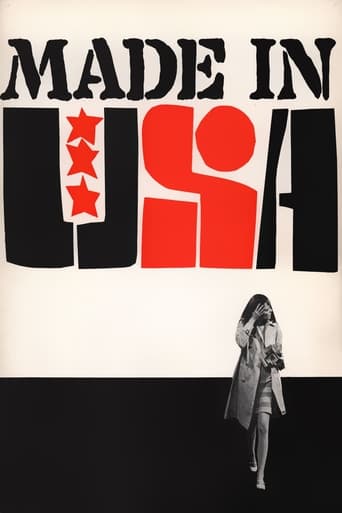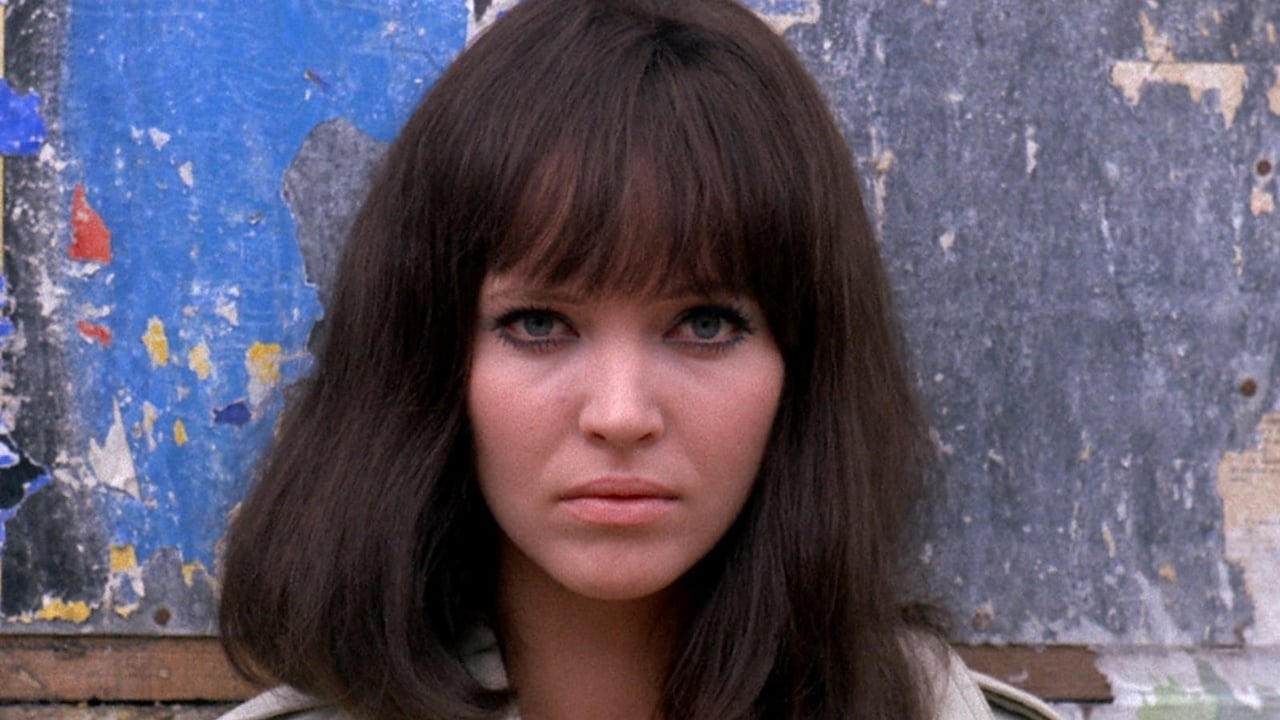Christopher Culver
In 1966 Jean-Luc Godard was approached by producer Georges de Beauregard, who said that he had some money he needed to spend and asked if Godard could make a film on very short notice. Godard said sure, and proposed adapting a pulp crime novel (Donald E. Westlake's "The Jugger"). But when Godard made the film, which would get the title MADE IN U.S.A., he did everything possible to break out of a straightforward adaptation, using the novel as a mere skeleton over which he could explore other themes that interested him.Paula (Anna Karina), a journalist, goes to a small town where her estranged boyfriend Richard has died in mysterious circumstances, surely murder. Determined to get to the bottom of things, she takes on the air of a hardboiled detective, wielding a pistol and wearing a Bogartian trenchcoat. She meets the doctor who did the autopsy and has a run-in with the police, but mainly we see her tangled up with two gangsters, played by László Szabó and Jean-Pierre Léaud.Godard maintains just enough conventional dialogue and action to let the viewer know where we are in the crime novel's plot, but most of what transpires before the camera must be understood as only abstract metaphors for what would have happened in the book. The interaction between his characters mainly has other purposes. They have absurdist conversations with a great deal of wordplay. They allude to French politics in a time when Godard was worried about the compromised values of the French Left and the spectres of fascism and consumer society. The Ben Barka affair, where a Moroccan dissident was murdered in France in 1965 with the apparent involvement of the French security services, looms very large over MADE IN U.S.A., almost elbowing Westlake's original story out entirely. As if aware that he had stripped the plot down to such a degree that he now had too much time to be filled, he gives little asides like Marianne Faithful singing "Tears Go By" a cappella in a cameo and Kyôko Kosaka strumming a guitar and singing in Japanese.This is not one of Godard's best films. For one, Godard reused many of the elements of his masterpiece PIERROT LE FOU from the year before. PIERROT LE FOU was itself assembled as sort of a collage of shots from Godard's prior films, which worked well as a wonderful summing up of his early career. But when he does the same with MADE IN U.S.A., it is to greatly diminished effect. But even if this is weak by Godard standards, it is nonetheless a moving experience. Shot in colour and in Cinemascope, this is a feast for the eyes. The very best of what the 1960s had to offer in terms of fashion and product design is on hand here and it just jumps of the screen. The image feels electric. (It is a pity that Criterion's edition is only on DVD, as a Blu-Ray would have yielded even greater pleasures.) Godard's longtime cameraman Raoul Coutard gives us some elaborate long takes that impress. And of course it's Godard's last major celebration of Anna Karina's beauty and poise, which really was something for the ages, still stunning half a century later.
valadas
As far as the meaningless images and dialogues let us know it looks like this is the story in the movie: A girl goes to a provincial town to investigate about her lover's murder and take her revenge on that. Once there she involves herself with one and another in obscure dialogues and nonsense sequences, ending up by killing two of them (because she thinks they were the killers or at least belong to the murderer's gang?) The motives of the supposed murder stay obscure and the movie develops itself in intersected images and sequences that explain little. And it finishes with the usual meaningless ending of Godard's movies. Godard is a movie director that most distinguished critics present as one of the greatest of our times who even influenced such directors (these are great indeed) as Altman, Scorsese, Wenders and Tarantino. Since till now I haven't seen a single of Godard's films that I liked I suppose that the fault must be mine. However I am not alone in this appreciation.
MartinHafer
Well, here I go again. I've seen quite a few Jean-Luc Godard movies and disliked quite a few of them. But then, like a dummy, I come back for more! That's because again and again, I hear how brilliant and creative his films are and I want to see this. But, once again, I see pretentiousness disguised in the form of creativity and unconventionality. And, once again, I see rave reviews that give him the absolutely highest possible scores. Yet I wonder, who is the audience? I know I am a reasonably bright and intellectual person (who has seen and reviewed a bazillion films and has six years of graduate school under my belt) and yet I hated the film--so who is the audience other than a small group of Godard acolytes? The point to this film, I assume, is that what we say isn't important. People talk and talk--for no apparent reason. People have names like 'Ruby Gentry' and 'Richard Widmark' and no one acts the least bit like any person in the real world--more like folks who live in a Bizarro World. All this in a city called Atlantic City--a fictitious French town in the near future--much like Godard's Alphaville. There's a lot more to the film than this, but I had a hard time forcing myself to watch it and frankly don't particularly care what occurred.I think I am done. I have seen ALPHAVILLE, FIRST NAME: CARMEN, PIERRE LE FOU and quite a few other seemingly pointless Godard films. I am done trying to understand or see value in them. It seems that for every good Godard film I enjoy, I see three others that bore me to tears. I guess I'm just a neanderthal.
jeremy-giroux
This film is really great and is typical of Godard films. I've seen that someone said on this board that the film wasn't good because another director had to direct it and Godard hadn't the rights but I really think that all this is a matter of justice and doesn't concern Cinema at all (and Godard has to be written with only two "d" and not three...). Anyway, this movie is great. It's full of non-sense, it's very poetic and we follow the beautiful Anna Karina trying to find and kill the people who killed her husband. It's a new experience of Cinema in the way to make movies, to write dialogs... it's a kind of reinvention. And you can see many famous people at the time of their youth like English singer Marianne Faithful, french actor Jean-Pierre Léaud and french writer Philipe Labro. It's a non-conventional film by someone who really experiment Cinema as an Art : Jean-Luc Godard.


 AD
AD



